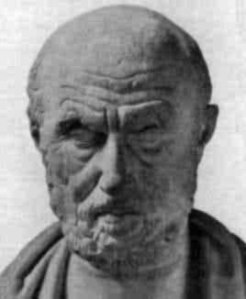Posts Tagged pre-Socratics
HIPPOCRATES of COS (c.470 – c.410 BCE)
Posted by historyofscience101 in BIOLOGY, GREEK PHILOSOPHY, HISTORY OF SCIENCE on February 22, 2014
Fifth/Fourth Century BCE – Greece
About 60 medical writings, known collectively as the Hippocratic corpus
Before the time of Hippocrates there had been little science in medicine. Disease was believed to be the punishment of the gods. Divine intervention came not from the natural, but from the supernatural.
‘Treatment’, therefore, came also from the supernatural, through magic, witchcraft, superstition or religious ritual. Hippocrates’ approach was remarkable given the age in which he lived. ‘There are in fact two things,’ said Hippocrates, ‘science and opinion’; the former begets knowledge, the latter ignorance.’
Although little is known about him, Hippocrates (Bukarat in the Muslim world) is now remembered as the Father of Medicine. He was a contemporary of Socrates and lived on the island of Cos. It is widely acknowledged that Hippocrates himself could not have written many of the texts attributed to him. Written over a century and varying widely in style and argument, it is thought they came from the medical school library of Cos, possibly put together in the first instance by the author to whom they later became attributed.
The corpus is the oldest surviving Western scientific text. It laid the foundations of the western medical tradition. Although its remedies are now considered ‘imaginative’, the corpus speaks the language of science; it does not speak of spells, daemons or gods.
Hippocrates cast aside superstition and focused on the natural, in particular observing, recording and analysing the symptoms and passages of disease. The prognosis of an illness was central to this approach to medicine, partly with a view to being able to avoid in the future the circumstances that were perceived to have initiated the problems in the first place. The development of far-fetched cures or drugs was not important. What came from nature should be cured by nature; therefore rest, healthy diet, exercise, hygiene and air were prescribed for the treatment and prevention of illness. [Vis medicatrix naturae – the healing power of nature]. The fact that Hippocrates was prescribing such a natural solution at all was a major advancement.
Hippocratic medicine was based on the balance of four elements – water (cold and moist), air (moist and hot), fire (hot and dry) and earth (cold and dry) – and four humors (bodily fluids) – phlegm, blood, yellow bile and black bile.
Whereas homeopathy attempts to treat disease by inducing in the patient symptoms similar to those displayed, according to the theory that symptoms are a manifestation of the body’s way of coping with the disease, allopathy describes a therapeutic technique that attempts a cure by inducing in the patient different symptoms. Basing treatment on symptoms, not causes, this enantiopathic technique can be fatal when applied to a system based on the humors. A person suffering from influenza is hot and thirsty (dry), so treatment with a mixture of cold and wet could result in a patient sitting a bath of cold water in a draughty room, awaiting a cure.
Personality or temperament was viewed as having four major types, sanguine, choleric, melancholic and phlegmatic.
Hippocrates regarded the body as a single entity, or whole, and the key lay in preserving the natural balance within this entity. Sickness was the sign of imbalance. When each of the factors was present in equal quantities, a healthy body would result. If one element became too dominant, then illness or disease would take over. If, for example, the sickness consisted of an excess of cold, moist humors, then the task of the physician was to restore the balance. The way to treat the problem would be by trying to undertake activities or eat foods which would stimulate the other humors, while at the same time trying to restrain the dominant one, in order to restore the balance and consequently, health.
The concept and treatment of humors endured for the next two thousand years, at least as far as the seventeenth century. The answers he prescribed for healthy living such as diet and exercise are still ‘good medicine’ and moreover, language introduced by Hippocrates still endures; an excess of black bile in Greek was ‘melancholic’, whilst someone with a too dominant phlegm humor became ‘phlegmatic’.
Physicians no longer practice Hippocratic medicine, but his name survives in the Hippocratic Oath that medical students take today.
The Oath, probably penned by one of his followers, is a short passage constituting a code of conduct to which henceforth all physicians were obliged to pledge themselves. It outlines, amongst other things, the ethical responsibilities of the doctor to his patients and a commitment to patient confidentiality – an attempt to set physicians in the Hippocratic tradition apart from the spiritual and superstitious healers of their day.
DEMOCRITUS of ABDERA (c.460 – c.370 BCE)
Posted by historyofscience101 in GREEK PHILOSOPHY, HISTORY OF SCIENCE, INDEX, THE ATOM on February 22, 2014
Fifth century BCE – Greece
Matter is made up of empty space and an infinite number of tiny invisible particles called atomos or atoms
Democritus reasoned that, if he were to attempt to cut an object in half over and over, he would eventually reach a tiny grain of matter that could not be cut in half. Democritus called these hypothetical building blocks of matter “atoms”, after the Greek atomos, ‘uncuttable’ – suggesting that atoms could not be divided indefinitely into smaller parts and that it is impossible to create new matter. All that you can see is a product of packing together a myriad of miniscule atoms.
He said that atoms were always in motion and as they moved about they collided with other atoms; sometimes they interlocked and held together, sometimes they rebounded from collisions. The Roman poet Lucretius (c.94 – c.55 BCE) imagined Democritus’ atoms with hooks that fastened them together.
Democritus’ atomic theory was probably based on previous ideas of other Greek philosophers. It was the first scientific attempt to explain the nature of matter; however, many of Democritus’ assumptions have now been proved wrong.
Democritus left no written record of his work and little is known about his life, but we know about his atomic theory from the second century CE Greek cynic and biographer Diogenes Laertius’ book ‘Lives of Eminent Philosophers’.
His remains one of the earliest attempts to explain the universe with a few simple physical and mathematical laws. For Democritus, there were only two things, space and atoms. Both had always existed and always would exist because de nihilo nihil ‘nothing could come from nothing’.
Balancing the idea that the atom is the only unit of being, the Void is the single kind of not being. The higher the atom-to-void ratio, the denser the material. Atoms simply combined with other atoms in the Void; solid, impenetrable, indivisible blocks which never change; they combine to form different things, from rocks to plants to animals. When these things died or fell apart the structure disintegrated and the atoms were free to form new things by combining again in a different shape with other atoms.
Democritus’ thesis completely rejects the notion of the spiritual or the religious. The soul was explainable through a fast-moving group of atoms brought together by encasement in the body. The motion produced sensations that interacted with the mind (itself a collection of atoms) to produce thoughts and feelings. Once dead, the object that held the fast-moving atoms disintegrated and thus released they could separate and interact with other atoms to form new things. Leaving no place for abstract notions of the supernatural or an afterlife, this marked the arrival of materialism.
Democritus reasoned that the method by which the atoms could combine was through their different shapes. While all the atoms were the same in substance, liquids were thought to have smooth round edges so they could fall over each other, while those that made up solids had toothed rough edges, which could hook on to each other.
Atoms of fire had tetragonal shape; atoms of earth, cubic; atoms of air, octahedral; and those of water were icosahedral. As with physical form, Democritus argued that other perceived differences in things, such as their taste, could be explained by the edges of the atoms. Likewise the colour of things was explained by the position of the atoms within a compound, which would result in darker or lighter shades.
Democritus had envisaged free atoms as flying about ceaselessly through empty space. What was needed therefore, was a precise picture of how atoms moved through space. Such a picture required knowledge of the laws that governed all motion.

Democritus crater
The Greek philosopher ARISTOTLE rejected Democritus’ idea of the atom and said that matter was completely uniform and continuous. The influence of Aristotle was extraordinary. His concept of matter was at variance with modern thinking, but it was accepted for around 20 centuries until it was replaced by DALTON‘s atomic theory in 1808.


 NEXT
NEXT

